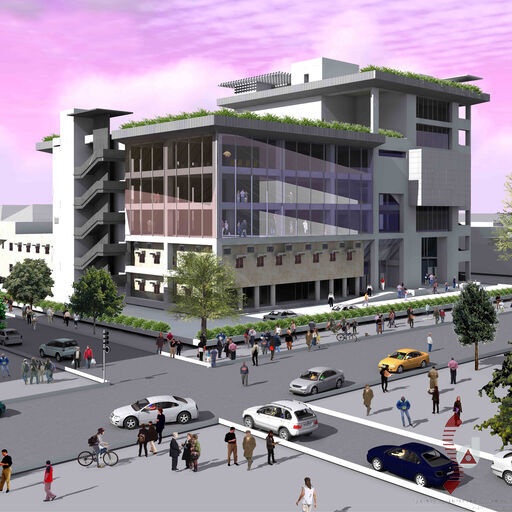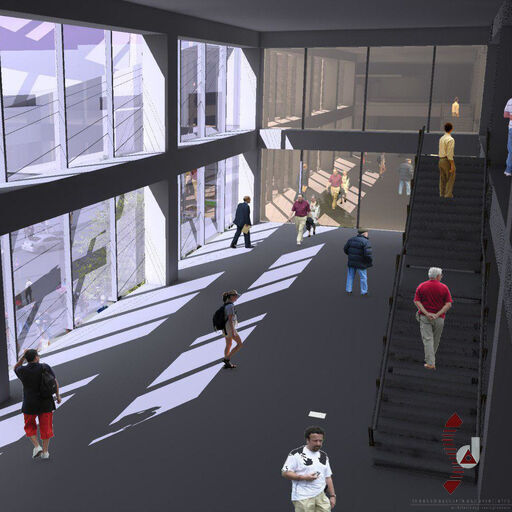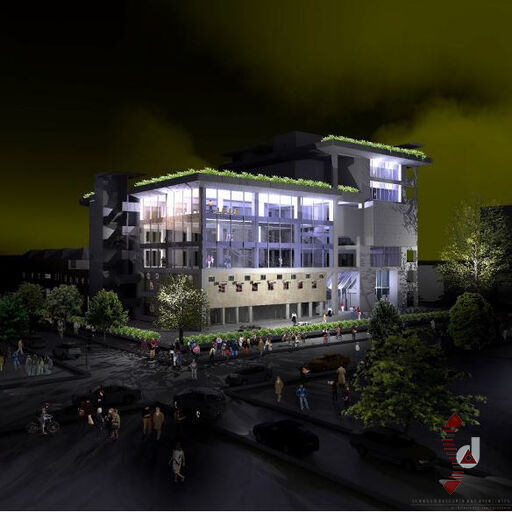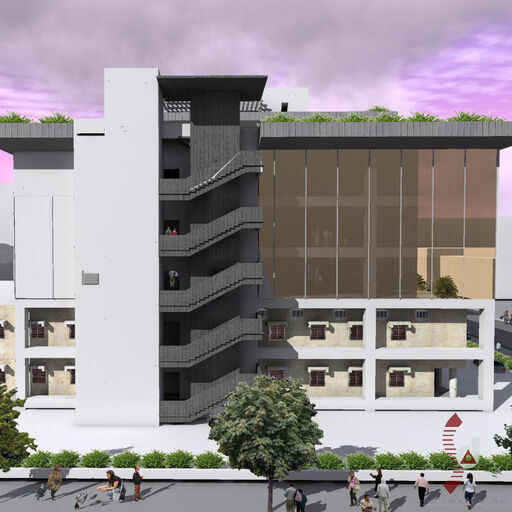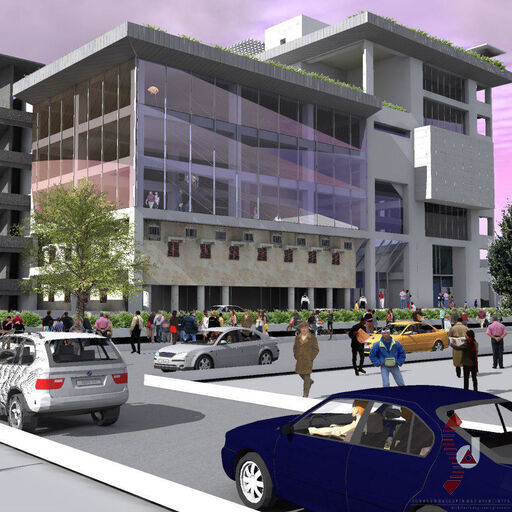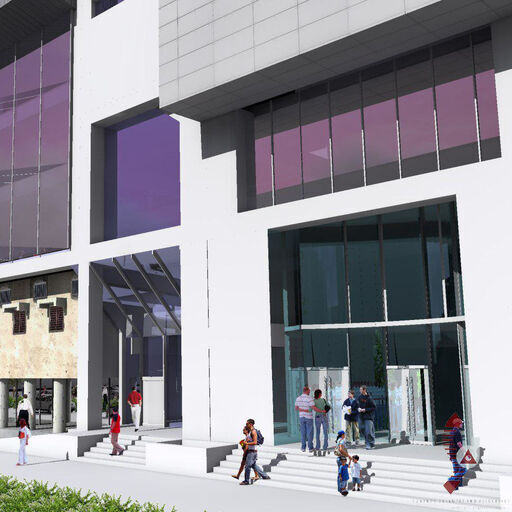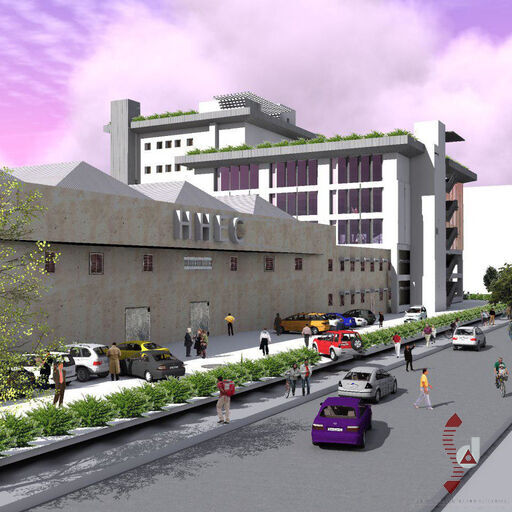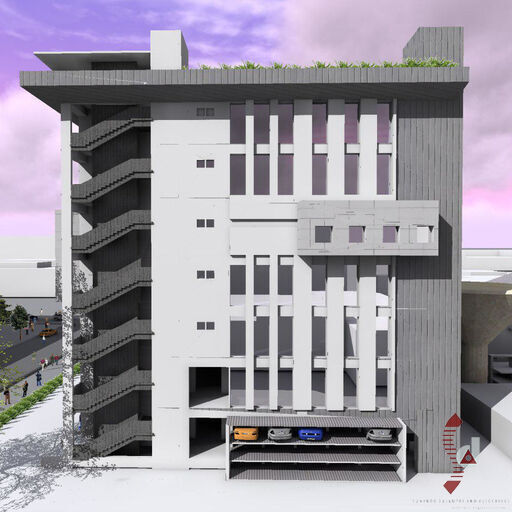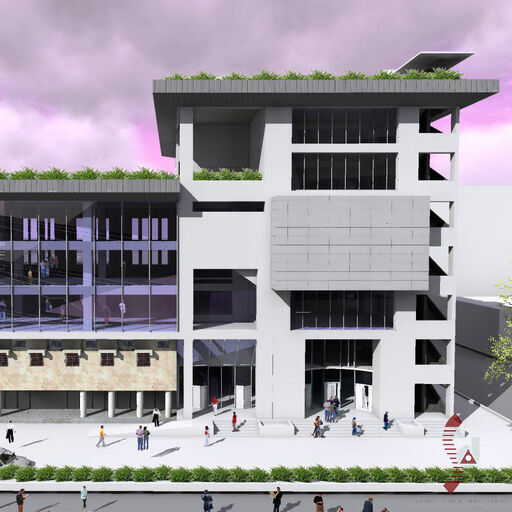HHEC Chennai is Institutional architectural project designed by SDAARCHITECT, located in Chennai, Tamil Nadu.
Project Info
| Client |
Handicrafts and Handlooms Export Corporation of India |
|---|---|
| Project Type |
Institutional |
| State |
Tamil Nadu |
| City | Chennai |
| Team |
Sunando Dasgupta Satya Sivakanth Jagan |
| Status | Design Proposal |
| Scale | Large-Scale Projects |
Architectural Renders
Site Analysis
The International Trade Hub proposed by Sunando Dasgupta and Associates is situated in the vibrant Guindy neighborhood of Chennai. This location, characterized by its dynamic blend of commercial and industrial developments, provides a rich context for the design of the new hub.
Location Assessment
Guindy, the area where the site is located, represents a complex urban landscape with varying scales of infrastructure and economic activity. To the west, the site is influenced by the presence of Jawaharlal Nehru Road and Olympia Tech Park, which are significant commercial and industrial landmarks. This western influence creates a pronounced east-west axis of large-scale development. Conversely, the north and south of the site are characterized by smaller-scale urban development. The intersection of these contrasting urban characteristics places the HHEC site at a crossroads, where its design must harmonize these diverse urban elements.
Site Assessment
The site itself is an amalgamation of existing structures, including low-rise factories, overhead water tanks, service buildings, and an office building of indeterminate character. This existing context necessitates a thoughtful approach to integrating and assimilating these structures into the new design. A key challenge is to incorporate these existing elements in a manner that does not undermine the iconic nature of the proposed International Trade Hub. The design must carefully negotiate the existing site conditions while aiming to enhance the overall architectural and functional quality of the new building.
Climate Assessment
The major axis of the site is oriented NNE-SSW, but the usable area is primarily organized around an EES-WWN axis. This orientation results in varying levels of exposure for different facades of the building. Consequently, each facade has been meticulously audited to ensure optimal performance and aesthetic consistency. The goal is to provide a balanced and comfortable experience across all facades, accounting for the diverse climatic impacts.
Design Concept
The design concept for the International Trade Hub, as envisioned by Sunando Dasgupta and Associates, is a blend of innovative structural solutions and aesthetic considerations, tailored to address the unique challenges and opportunities presented by the site.
Design Philosophy
The core objective of the design is to create an iconic building that harmonizes with its complex site conditions. This involves addressing the integration of existing structures and adapting to the local climate while achieving a distinctive architectural identity. The design concept embraces these challenges by incorporating both pragmatic and aesthetic elements into a cohesive whole.
Building Massing
The building massing is fundamentally shaped by two key factors: the building footprint and the structural system. The footprint of the building encourages vertical expansion, while the use of Vierendeel trusses introduces a horizontal dimension. This massing strategy results in a structure that combines vertical extrusion with a pronounced horizontal block, creating a visually dynamic and structurally efficient form. The building’s massing is further enhanced through careful manipulation of structural members, surface treatments, and transparencies to achieve a refined aesthetic.
Building Facade
The facade design is a critical component of the building’s aesthetic and functional performance. Different orientations of the building are treated with distinct facade treatments:
- North and Northeast Faces: These facades are characterized by structural glazing and a high degree of transparency. This approach maximizes natural light and creates a visually open and inviting appearance.
- South and Southwest Faces: These facades feature smaller apertures, deeply recessed windows, and brise soleil (sunbreakers). This configuration reduces solar gain and glare while enhancing the building’s energy efficiency.
The facade strategies are designed to provide a harmonious blend of traditional and contemporary elements, ensuring that the building meets functional needs while contributing to the overall urban character of the area.
South and Southwest Faces:
These facades feature smaller apertures, deeply recessed windows, and brise soleil (sunbreakers). This configuration reduces solar gain and glare while enhancing the building’s energy efficiency.
The facade strategies are designed to provide a harmonious blend of traditional and contemporary elements, ensuring that the building meets functional needs while contributing to the overall urban character of the area.
Sustainability and Green Building Proposals
The design incorporates several sustainability and green building measures, including:
- Site Planning: Protecting existing site features and optimizing outdoor lighting and utility efficiency.
- Building Planning: Maximizing resource conservation, reducing water and energy requirements, and utilizing renewable energy sources.
- Construction Practices: Minimizing waste, ensuring healthy indoor air quality, and using low-VOC materials to enhance environmental performance.
These strategies aim to create a building that not only meets current sustainability standards but also contributes positively to the surrounding environment and community.
Site Layout
The site layout for the International Trade Hub, designed by Sunando Dasgupta and Associates, is meticulously planned to address both functional and regulatory requirements, ensuring efficient use of space and streamlined access.
Setbacks and Access
The proposed site layout includes specific setbacks and access points to comply with and exceed local development regulations. The front setback is designed at 8 meters, while side setbacks are set at 6 meters, adhering to the Second Master Plan for Chennai Metropolitan Area, 2026.
To facilitate efficient traffic flow and site accessibility, the existing gate facing east has been retained. Additionally, two new gates are proposed along the northern and eastern edges of the site. This configuration ensures separate entry and exit routes, avoiding cul-de-sacs and promoting streamlined movement through the site. Two security cabins are proposed at the site entries, enhancing security and access control.
Site Services
Key site services are strategically located to support the building's operations and minimize disruption. The rear side of the building, adjacent to the water tank, is dedicated to essential services, including:
- Stack parking
- DG sets (silent type)
- Compact substation
- Electric room
- Rainwater harvesting pit
Rainwater Harvesting
Four rainwater harvesting pits are proposed at the four corners of the plot to enhance water sustainability. In addition, an additional borehole is planned to augment the municipal water supply, subject to regulatory compliance.
Water Treatment Plant
Given the high Total Dissolved Solids (TDS) content in Chennai's water, a water treatment plant is included in the design to ensure the provision of clean, potable water.
Sewage Treatment Plant
A sewage treatment plant is also proposed as part of the green building measures. This facility will enable wastewater recycling and efficient solid waste management, aligning with the project's sustainability goals.
Functional Layout
The functional layout of the International Trade Hub, designed by Sunando Dasgupta and Associates, is strategically organized to optimize the use of space and ensure efficient operations throughout the building. Each floor is purposefully designed to accommodate specific functions and activities, reflecting the building’s diverse programmatic needs.
Building Organization – Programme
The building’s programmatic elements are distributed across various floors, each serving distinct functions:
Basement:
This level includes a common store and plant room. The common store is a mechanically ventilated loft space with additional ventilation provided through peripheral windows. This level also marks the termination of the central service core and one of the peripheral service cores.
Ground Floor/Raised Plinth:
The ground floor features a showroom, strategically located for maximum visibility and easy access. It includes a separate double-height entrance atrium for direct access, bypassing the central atrium and service cores. The showroom is flanked by one of the peripheral service cores.
First Floor:
This floor also houses showrooms, which are internally connected to the ground floor, extending the space below and enhancing operational continuity.
Second & Third Floors:
These floors are dedicated to the library and gallery. Both spaces have institutional characteristics and feature substantial double-height areas to promote visual permeability. The gallery is integrated into the Vierendeel structure to leverage its regular grid and large-span lofts, accommodating various exhibits from small artifacts to larger installations.
Fourth Floor:
This floor includes an auditorium and convention center. The auditorium is designed with a sloped floor that aligns with the double-height library below. It features an independent entry, lobby, and separate lifts to handle high occupancy efficiently. The convention center includes a primary space for 80 to 100 occupants, two conference rooms, and a fully equipped restaurant and kitchen. These spaces are connected to a large common pre-function area.
Fifth Floor:
The fifth floor accommodates office spaces, designed with a column-free layout to ensure flexible workspaces. The northern side of this floor opens onto a garden terrace, which also serves as a refuge area. The terrace is utilized as a green roof, and the structural system is designed to support potential future vertical expansion.
Sixth Floor:
This floor continues the office layout from the fifth floor, maintaining a column-free design to support flexible office configurations.
Terrace & Mumty:
The terrace features a garden, service areas, and cooling towers, contributing to a recreational zone and reducing heat load on the roof. A pergola on the southern side offers space for occasional outdoor gatherings. Solar panels are installed on the terrace for hot water needs, adding both functionality and aesthetic value. The mumty houses overhead tanks and other ancillary services.
Building Organization – Services
The building’s service organization is designed to optimize functionality and safety:
Central Atrium Spine:
The atrium spine centralizes services common to both building masses, creating a shared void that unifies the structure while distinguishing its components.
Central Services:
This core includes washrooms, toilets for differently-abled individuals, air handling units (AHUs), a panel room, and a main staircase that connects the building’s masses.
Peripheral Services:
Supplementing the central core, peripheral service cores on either side of the building house fire stairs, freight and food lifts, additional toilets, and service shafts. These cores are strategically placed to optimize fire exits and evacuation routes, with two staircases provided as per national building codes to ensure safety.
Toilets:
Toilet blocks are strategically placed on external walls or facing shafts, including separate facilities for men, women, and those with disabilities, in compliance with national building codes.
Movement and Circulation
The movement and circulation strategy for the International Trade Hub, designed by Sunando Dasgupta and Associates, is a crucial aspect of the building’s functionality. The design ensures efficient flow of people and vehicles, enhances accessibility, and optimizes operational efficiency.
Site Access and Traffic Flow
The site layout is designed to facilitate smooth traffic movement and accessibility. The proposed layout includes:
Separate Entry and Exit:
To avoid traffic congestion and streamline vehicle movement, the site features distinct entry and exit points. This design choice helps prevent cul-de-sacs and ensures a seamless flow of traffic through the site.
Gates and Security Cabins:
The existing gate facing east is retained, and two new gates are proposed along the northern and eastern edges. Two security cabins at these entry points enhance security and access control.
Building Circulation
The internal circulation within the building is designed to support both efficient movement and accessibility:
Central Atrium Spine:
The central atrium spine acts as a focal point for circulation, connecting the various parts of the building and facilitating movement between different zones. It centralizes common services and introduces a shared void that enhances connectivity across the building.
Vertical Circulation:
The building features a central service core that includes essential amenities such as washrooms, toilets, air handling units (AHUs), and a main staircase. This core connects both building masses and supports vertical movement within the structure.
Peripheral Service Cores:
Supplementing the central core, the peripheral service cores are equipped with fire stairs, freight and food lifts, additional toilets, and service shafts. These cores are strategically located to optimize fire exit routes and evacuation times. Two staircases are provided to meet national building codes, ensuring safe and efficient egress in emergencies.
Accessibility:
The building’s design includes accessible features such as toilets for differently-abled individuals and clear pathways to ensure compliance with accessibility standards. The layout is designed to facilitate easy movement for all occupants, including those with disabilities.
Functional Zones and Circulation
The functional layout of the building is organized to support effective circulation:
Ground Floor/Raised Plinth:
The showroom on the ground floor includes a separate double-height entrance atrium for direct access, bypassing the central atrium and service cores. This arrangement ensures easy access and visibility for visitors.
Auditorium and Convention Centre:
Located on the fourth floor, the auditorium is designed with independent entry and exit points to manage large crowds efficiently. The convention centre is linked to the service core and food lifts, optimizing the movement of people and goods.
Overall, the movement and circulation design of the International Trade Hub prioritizes efficiency, safety, and accessibility, ensuring a well-organized and functional environment for all users.
